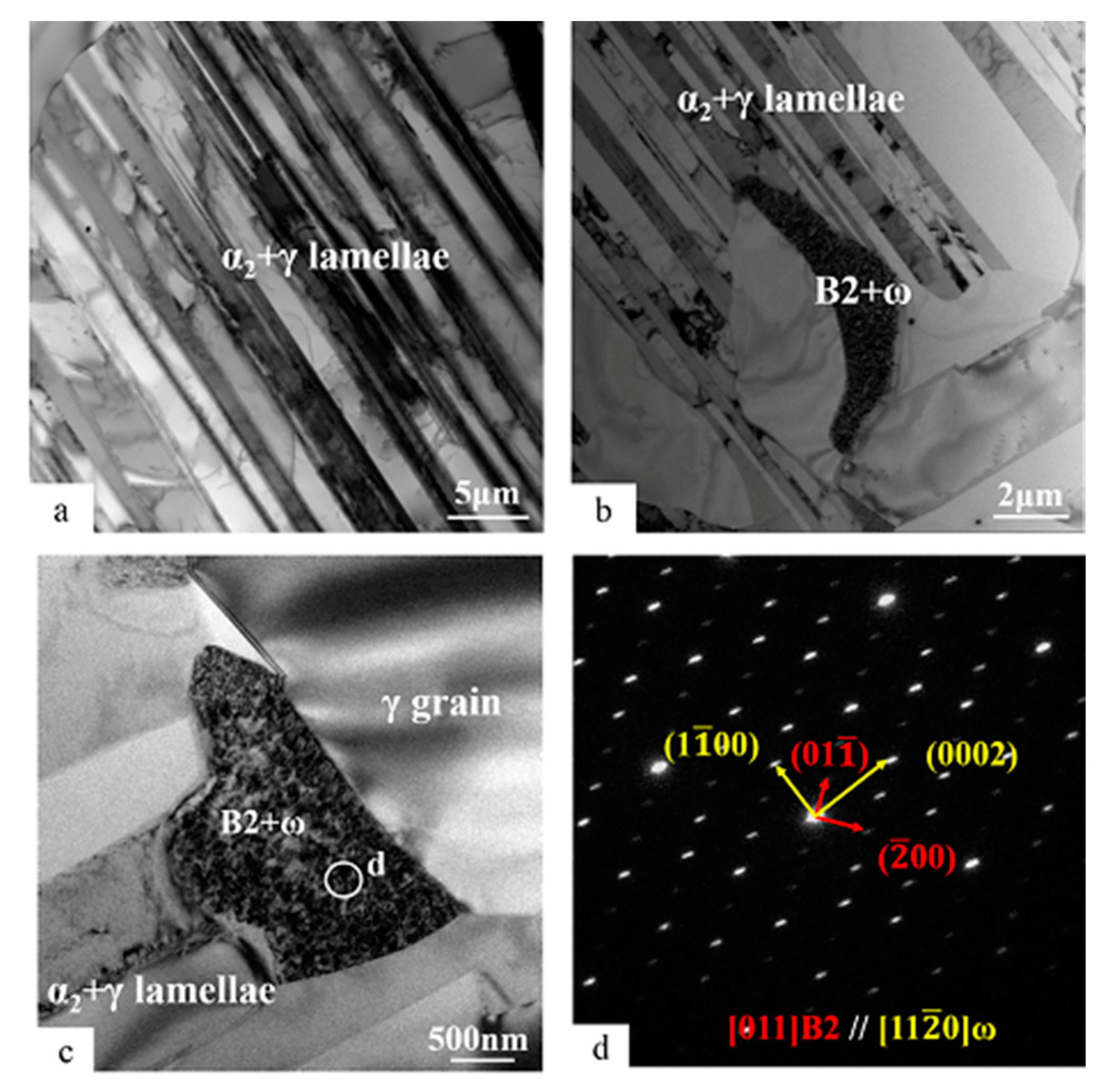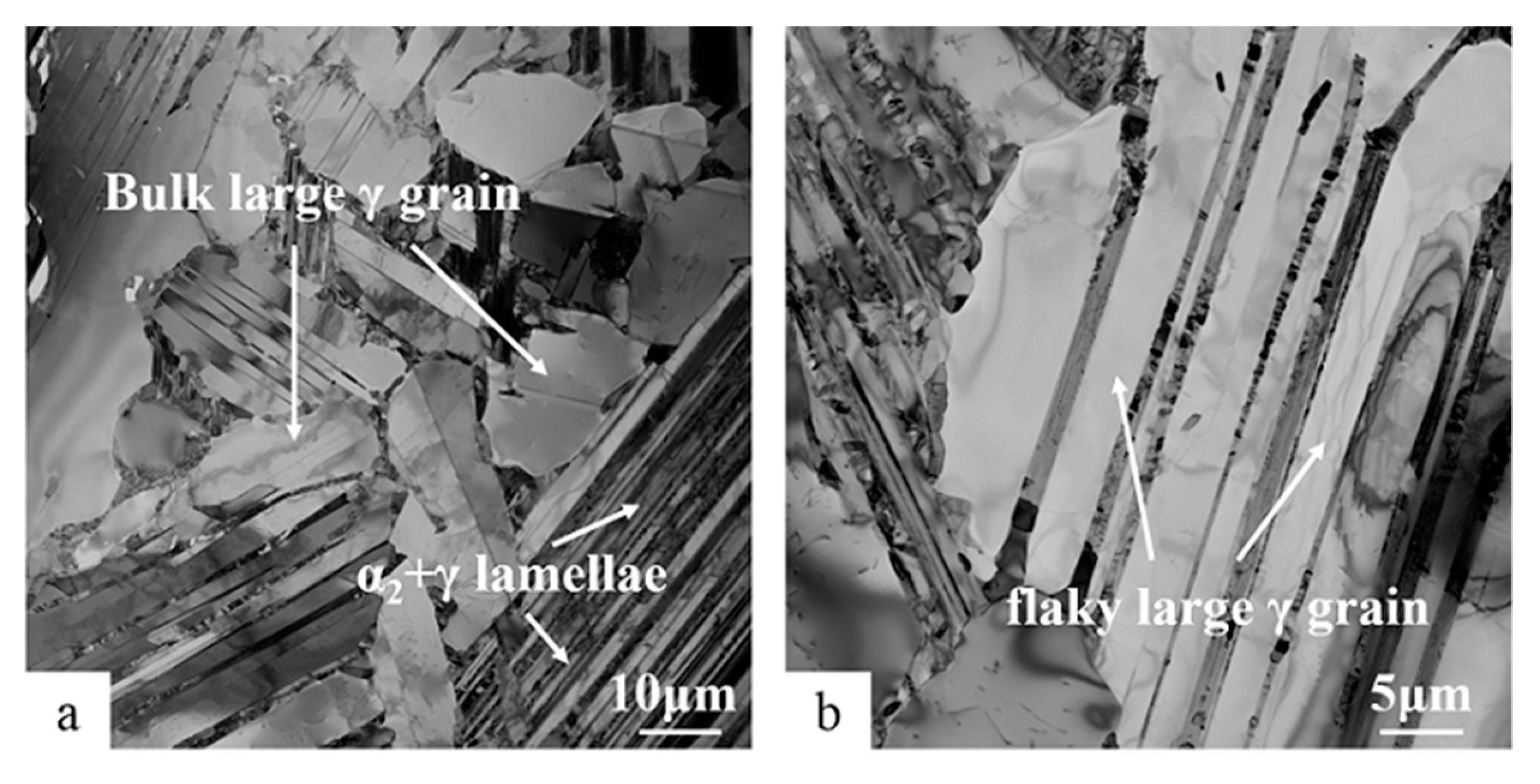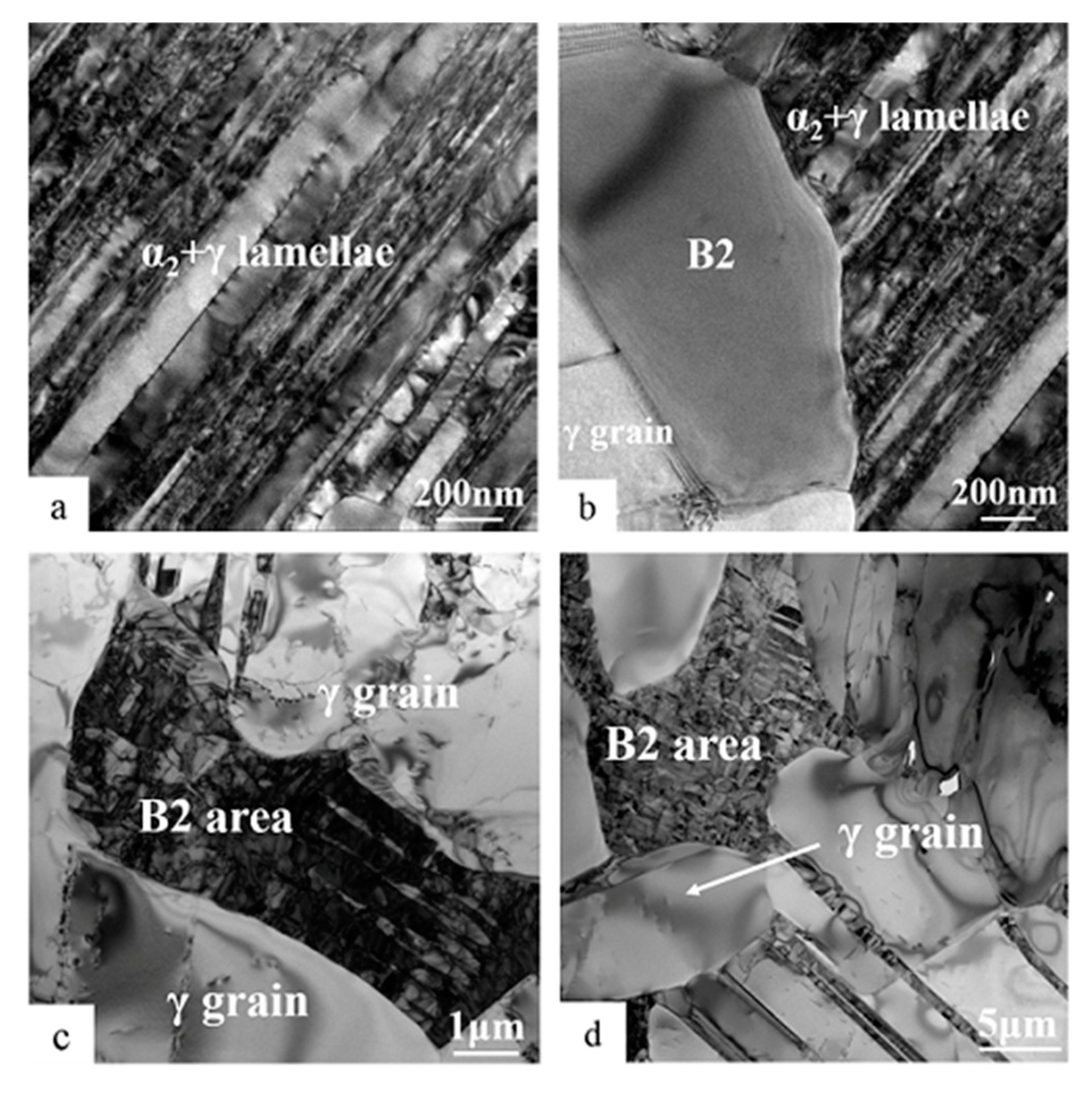Microstructure Evolution of Ti-45Al-8.5Nb-0.2W-0.2B-0.02Y Alloy during Long-Term Thermal Exposure
Abstract
:1. Introduction
2. Materials and Methods
3. Results
3.1. BSE Images of Unexposed and Exposed Microstructures
3.2. TEM Examination of Unexposed Microstructures
3.3. Observation of Microstructure Changes during 10,000 h Exposure by Transmission Electron Microscopy
3.3.1. Bulk and Flaky Large γ Grains Appear after 5000 h and Exposure
3.3.2. A Large Amount of B2(ω) is Precipitated at the α2 + γ Lamellae Boundary and the γ/γ Interfaces during Long-Term Exposure
3.3.3. The γ Phase Precipitated in the B2 Area after 5000 and 10,000 h Exposure
4. Discussion
5. Conclusions
Author Contributions
Funding
Conflicts of Interest
References
- Loria, E.A. Gamma titanium aluminides as prospective structural materials. Intermetallics 2000, 8, 1339–1345. [Google Scholar] [CrossRef]
- Tetsui, T. Gamma Ti aluminides for non-aerospace applications. Curr. Opin. Solid State Mater. Sci. 1999, 4, 243–248. [Google Scholar] [CrossRef]
- Djanarthany, S.; Viala, J.C.; Bouix, J. An overview of monolithic titanium aluminides based on Ti3Al and TiAl. Mater. Chem. Phys. 2001, 72, 301–319. [Google Scholar] [CrossRef]
- Yamaguchi, M.; Inui, H.; Ito, K. High-temperature structural intermetallics. Acta Mater. 2000, 48, 307–322. [Google Scholar] [CrossRef]
- Appel, F.; Oehring, M.; Wagner, R. Novel design concepts for gamma-base titanium aluminide alloys. Intermetallics 2000, 8, 1283–1312. [Google Scholar] [CrossRef]
- Cheng, T.T.; Loretto, M.H. The decomposition of the beta phase in Ti-44Al-8Nb and Ti-44Al-4Nb-4Zr-0.2Si alloys. Acta Mater. 1998, 46, 4801–4819. [Google Scholar] [CrossRef]
- Appel, F.; Brossmann, U.; Christoph, U.; Eggert, S.; Janschek, P.; Lorenz, U.; Müllauer, J.; Oehring, M.; Paul, J.D.H. Recent Progress in the Development of Gamma Titanium Aluminide Alloys. Adv. Eng. Mater. 2000, 2, 699–720. [Google Scholar] [CrossRef]
- Xu, X.J.; Lin, J.P.; Wang, Y.L.; Gao, J.F.; Lin, Z.; Chen, G.L. Microstructure and tensile properties of as-cast Ti–45Al–(8–9)Nb–(W, B, Y) alloy. J. Alloys Compd. 2006, 414, 131–136. [Google Scholar] [CrossRef]
- Lin, J.P.; Xu, X.J.; Wang, Y.L.; He, S.F.; Zhang, Y.; Song, X.P.; Chen, G.L. High temperature deformation behaviors of a high Nb containing TiAl alloy. Intermetallics 2007, 15, 668–674. [Google Scholar] [CrossRef]
- Liu, C.T. Recent Advances in Ordered Intermetallics. Mater. Chem. Phys. 1995, 288, 77–86. [Google Scholar] [CrossRef] [Green Version]
- Kainuma, R.; Fujita, Y.; Mitsui, H.; Ohnuma, I.; Ishida, K. Phase equilibria among α (hcp), β (bcc) and γ (L1 0) phases in Ti–Al base ternary alloys. Intermetallics 2000, 8, 855–867. [Google Scholar] [CrossRef]
- Paul, J.D.H.; Appel, F.; Wagner, R. The compression behaviour of niobium alloyed γ-titanium alumindies. Acta Mater. 1998, 46, 1075–1085. [Google Scholar] [CrossRef]
- Dobromyslov, A.V.; Elkin, V.A. Martensitic transformation and metastable β-phase in binary titanium alloys with d-metals of 4–6 periods. Scr. Mater. 2001, 44, 905–910. [Google Scholar] [CrossRef]
- Yan, Y.Q.; Zhou, L.; Wang, W.S.; Zhang, Y.N. 8.5Nb–TiAl alloy with fine grains. J. Alloys Compd. 2003, 361, 241–246. [Google Scholar] [CrossRef]
- Herzig, C.; Przeorski, T.; Friesel, M.; Hisker, F.; Divinski, S. Tracer solute diffusion of Nb, Zr, Cr, Fe, and Ni in γ-TiAl: Effect of preferential site occupation. Intermetallics 2001, 9, 461–472. [Google Scholar] [CrossRef]
- Lin, J.P.; Zhao, L.L.; Li, G.Y.; Zhang, L.Q.; Song, X.P.; Ye, F.; Chen, G.L. Effect of Nb on oxidation behavior of high Nb containing TiAl alloys. Intermetallics 2011, 19, 131–136. [Google Scholar] [CrossRef]
- Schloffer, M.; Rashkova, B.; SchöBerl, T.; Schwaighofer, E.; Zhang, Z.; Clemens, H.; Mayer, S. Evolution of the ωo phase in a β-stabilized multi-phase TiAl alloy and its effect on hardness. Acta Mater. 2014, 64, 241–252. [Google Scholar] [CrossRef]
- Qiang, F.M.; Kou, H.C.; Tang, B.; Song, L.; Lia, J. Effect of cooling rate on microstructure evolution of Ti-45Al-8.5Nb-0.2W-0.2B-0.02Y alloy during multi-step heat treatment. Mater. Charact. 2018, 145, 210–217. [Google Scholar] [CrossRef]
- Cheng, T.T.; Willis, M.R.; Jones, I.P. Effects of major alloying additions on the microstructure and mechanical properties of γ-TiAl. Intermetallics 1999, 7, 89–99. [Google Scholar] [CrossRef]
- Strychor, R.; Williams, J.C.; Soffa, W.A. Phase Transformations and Modulated Microstructures in Ti-Al-Nb Alloys. Metall. Mater. Trans. A 1998, 19, 225–234. [Google Scholar] [CrossRef]
- Sharma, G.; Ramanujan, R.V.; Tiwari, G.P. Interphase precipitation in a γ-TiAl alloy. Mater. Sci. Eng. A 1999, 269, 21–25. [Google Scholar] [CrossRef]
- Tanaka, K.; Okamoto, K.; Inui, H.; Minonishi, Y.; Yamaguchi, M.; Koiwa, M. Elastic constants and their temperature dependence for the intermetallic compound Ti3Al. Philos. Mag. A 1996, 73, 1475–1488. [Google Scholar] [CrossRef]
- Zhang, W.J.; Deevi, S.C.; Chen, G.L. On the origin of superior high strength of Ti–45Al-10Nb alloys. Intermetallics 2002, 10, 403–406. [Google Scholar] [CrossRef]
- Huang, Z.W.; Voice, W.E.; Bowen, P. Thermal stability of Ti–46Al–5Nb–1W alloy. Mater. Sci. Eng. A 2002, 329, 435–445. [Google Scholar] [CrossRef]
- Inkson, B.J.; Clemens, H.; Marien, J. γ α2 B2 Lamellar Domains in Rolled TiAl. Scr. Mater. 1998, 38, 1377–1382. [Google Scholar] [CrossRef]
- Fang, L.; Ding, X.F.; He, J.P.; Zhang, L.Q.; Lin, Z.; Lin, J.P. Microstructure instability of fully lamellar TiAl alloy containing high content of Nb after long-term thermal cycling. Trans. Nonferrous. Met. Soc. China 2014, 24, 3095–3102. [Google Scholar] [CrossRef]
- Huang, Z.W.; Hu, W. Thermal stability of an intermediate strength fully lamellar Ti–45Al–2Mn–2Nb-0.8 vol.% TiB2 alloy. Intermetallics 2014, 54, 49–55. [Google Scholar] [CrossRef]
- Hu, D.; Godfrey, A.B.; Loretto, M.H. Thermal stability of a fully lamellar Ti-48Al-2Cr-2Nb-1B alloy. Intermetallics 1998, 6, 413–417. [Google Scholar] [CrossRef]
- Beschliesser, M.; Chatterjee, A.; Lorich, A.; Knabl, W.; Kestler, H.; Dehm, G.; Clemens, H. Designed fully lamellar microstructures in a γ-TiAl based alloy: Adjustment and microstructural changes upon long-term isothermal exposure at 700 and 800 °C. Mater. Sci. Eng. A 2002, 329, 124–129. [Google Scholar] [CrossRef]
- Huang, Z.W.; Cong, T. Microstructural instability and embrittlement behaviour of an Al-lean, high-Nb γ-TiAl-based alloy subjected to a long-term thermal exposure in air. Intermetallics 2010, 18, 161–172. [Google Scholar] [CrossRef]
- Huang, Z.W.; Voice, W.; Bowen, P. Effects of long-term air exposure on the stability of lamellar TiAl alloys. Intermetallics 2000, 8, 417–426. [Google Scholar] [CrossRef]
- Huang, Z.W.; Voice, W.; Bowen, P. Thermal exposure induced α2+γ→B2(ω) and α2→B2(ω) phase transformations in a high Nb fully lamellar TiAl alloy. Scr. Mater. 2003, 48, 79–84. [Google Scholar] [CrossRef]
- Huang, Z.W. Ordered ω phases in a 4Zr–4Nb-containing TiAl-based alloy. Acta. Mater. 2008, 56, 1689–1700. [Google Scholar] [CrossRef]
- Song, L.; Zhang, L.Q.; Xu, X.J.; Sun, J.; Lin, J.P. Omega phase in as-cast high-Nb-containing TiAl alloy. Scr. Mater. 2013, 68, 929–932. [Google Scholar] [CrossRef]
- Song, L.; Peng, C.; Xu, X.J.; You, L.; Wang, Y.L.; Lin, J.P. ωo phase precipitation in annealed high Nb containing TiAl alloys. Prog. Nat. Sci. Mater. Int. 2015, 25, 147–152. [Google Scholar] [CrossRef] [Green Version]
- Huang, Z.W. Thermal stability of Ti-44Al-4Nb-4Zr-0.2Si-1B alloy. Intermetallics 2013, 42, 170–179. [Google Scholar] [CrossRef]
- Chen, G.L.; Xu, X.J.; Teng, Z.K.; Wang, Y.L.; Lin, J.P. Microsegregation in high Nb containing TiAl alloy ingots beyond laboratory scale. Intermetallics 2007, 15, 625–631. [Google Scholar] [CrossRef]
- Wang, Y.H.; Lin, J.P.; He, Y.H.; Wang, Y.L.; Chen, G.L. Microstructure and mechanical properties of as-cast Ti–45Al–8.5Nb–(W,B,Y) alloy with industrial scale. Mater. Sci. Eng. A 2007, 471, 82–87. [Google Scholar] [CrossRef]
- Wang, Y.H.; Lin, J.P.; He, Y.H.; Wang, Y.L.; Chen, G.L. Microstructures and mechanical properties of Ti–45Al–8.5Nb–(W,B,Y) alloy by SPS–HIP route. Mater. Sci. Eng. A 2008, 489, 55–61. [Google Scholar] [CrossRef]
- Huang, Z.W. Inhomogeneous microstructure in highly alloyed cast TiAl-based alloys, caused by microsegregation. Scr. Mater. 2005, 52, 1021–1025. [Google Scholar] [CrossRef]
- Huang, Z.W.; Zhu, D.G. Thermal stability of Ti–44Al–8Nb–1B alloy. Intermetallics 2008, 16, 156–167. [Google Scholar] [CrossRef]
- Huang, Z.W. Thermal stability of Ti-44Al-4Nb-4Hf-0.2Si-1B alloy. Intermetallics 2013, 37, 11–21. [Google Scholar] [CrossRef]
- Silcock, J.M. An X-ray examination of the to phase in TiV, TiMo and TiCr alloys. Acta Metall. 1958, 6, 481–493. [Google Scholar] [CrossRef]
- Takeyama, M.; Kobayashi, S. Physical metallurgy for wrought gamma titanium aluminides: Microstructure control through phase transformations. Intermetallics 2005, 13, 993–999. [Google Scholar] [CrossRef]
- Fang, L.; Lin, J.P.; Ding, X.F. Thermal cycling induced microstructural instability in fully lamellar Ti-45Al-8.5Nb-(W, B, Y) alloys. Mater. Chem. Phys. 2015, 167, 112–118. [Google Scholar] [CrossRef]
- Song, L.; Xu, X.J.; You, L.; Liang, Y.F.; Lin, J.P. Phase transformation and decomposition mechanisms of the βo(ω) phase in cast high Nb containing TiAl alloy. J. Alloys Compd. 2014, 616, 483–491. [Google Scholar] [CrossRef]
- Song, L.; Xu, X.J.; You, L.; Liang, Y.F.; Lin, J.P. Ordered omega phase transformations in Ti-45Al-8.5Nb-0.2B alloy. Intermetallics 2015, 65, 22–28. [Google Scholar] [CrossRef]
- Mishin, Y.; Herzig, C. Diffusion in the Ti-Al system. Acta. Mater. 2000, 48, 589–623. [Google Scholar] [CrossRef]
- Du, X.W.; Zhu, J.; Zhang, X.; Cheng, Z.Y.; Kim, Y.W. Creep induced α2→β2 phase transformation in a fully-lamellar TiAl alloy. Scr. Mater. 2000, 43, 597–602. [Google Scholar] [CrossRef]
- Pond, R.C.; Shang, P.; Cheng, T.T.; Aindow, M. Interfacial dislocation mechanism for diffusional phase transformations exhibiting martensitic crystallography: Formation of TiAl + Ti3Al lamellae. Acta. Mater. 2000, 48, 1047–1053. [Google Scholar] [CrossRef]






| Exposure Time (h) | Volume Fraction (%) | Size (μm) | ||||
|---|---|---|---|---|---|---|
| B2(ω) | Equiaxial γ | α2 +γ Lamella | B2(ω) | Equiaxial γ | α2 +γ Lamella | |
| 0 | 2.2 ± 0.3 | 57.6 ± 3.2 | 40.2 ± 3.5 | 10.3 ± 1.5 | 20.9 ± 3.4 | 36.2 ± 1.3 |
| 3000 | 3.7 ± 0.4 | 58.5 ± 4.1 | 37.8 ± 4.2 | 16.4 ± 3.2 | 23.3 ± 1.6 | 45.5 ± 2.7 |
| 5000 | 6.5 ± 0.2 | 61.3 ± 3.7 | 32.3 ± 3.8 | 24.4 ± 2.7 | 27.2 ± 2.3 | 32.3 ± 2.4 |
| 10,000 | 16.8 ± 2.4 | 63.2 ± 4.3 | 20.0 ± 4.3 | 28.8 ± 1.1 | 47.5 ± 3.8 | 26.6 ± 3.5 |
| Element | Composition of Major Constituents (at. %) | Partition Factor k | ||||
|---|---|---|---|---|---|---|
| β (B2 + ω) | γ | α2 | K(β/γ) | K(β/α2) | K(α2/γ) | |
| Ti | 52.6 ± 1.2 | 44.5 ± 0.9 | 52.5 ± 0.8 | 1.18 | 1.00 | 1.17 |
| Al | 34.4 ± 0.4 | 46.0 ± 0.8 | 37.8 ± 0.7 | 0.75 | 0.91 | 0.82 |
| Nb | 12.1 ± 0.2 | 9.2 ± 0.3 | 9.4 ± 0.2 | 1.32 | 1.29 | 1.02 |
| W | 0.9 ± 0.2 | 0.3 ± 0.1 | 0.3 ± 0.1 | 3.00 | 3.00 | 1.00 |
© 2020 by the authors. Licensee MDPI, Basel, Switzerland. This article is an open access article distributed under the terms and conditions of the Creative Commons Attribution (CC BY) license (http://creativecommons.org/licenses/by/4.0/).
Share and Cite
Chen, Z.; Cai, Z.; Jiang, X.; Chen, S.; Huang, Z.; Sun, H. Microstructure Evolution of Ti-45Al-8.5Nb-0.2W-0.2B-0.02Y Alloy during Long-Term Thermal Exposure. Materials 2020, 13, 1638. https://doi.org/10.3390/ma13071638
Chen Z, Cai Z, Jiang X, Chen S, Huang Z, Sun H. Microstructure Evolution of Ti-45Al-8.5Nb-0.2W-0.2B-0.02Y Alloy during Long-Term Thermal Exposure. Materials. 2020; 13(7):1638. https://doi.org/10.3390/ma13071638
Chicago/Turabian StyleChen, Zhiyuan, Zhengkun Cai, Xiaosong Jiang, Song Chen, Zewen Huang, and Hongliang Sun. 2020. "Microstructure Evolution of Ti-45Al-8.5Nb-0.2W-0.2B-0.02Y Alloy during Long-Term Thermal Exposure" Materials 13, no. 7: 1638. https://doi.org/10.3390/ma13071638





